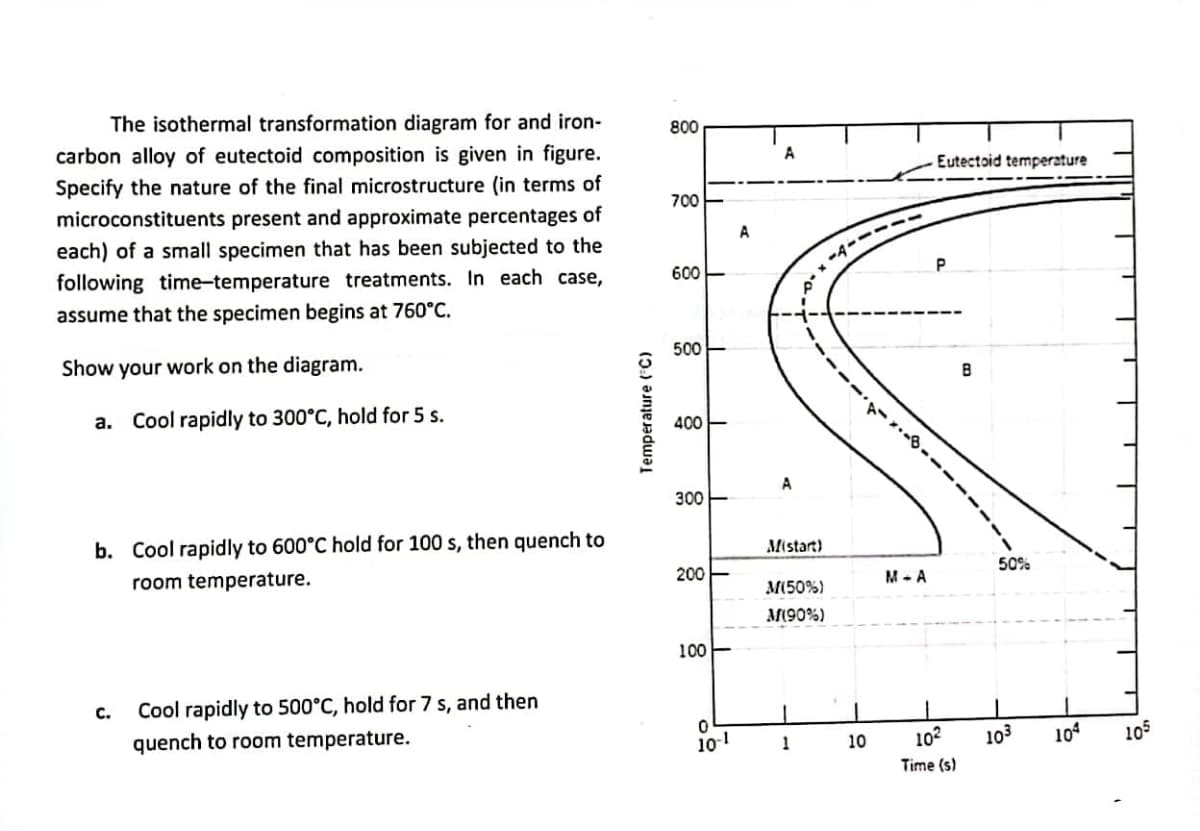The isothermal transformation diagram for and iron- carbon alloy of eutectoid composition is given in figure. Specify the nature of the final microstructure (in terms of microconstituents present and approximate percentages of each) of a small specimen that has been subjected to the following time-temperature treatments. In each case, assume that the specimen begins at 760°C. Show your work on the diagram. a. Cool rapidly to 300°C, hold for 5 s. b. Cool rapidly to 600°C hold for 100 s, then quench to room temperature. C. Cool rapidly to 500°C, hold for 7 s, and then quench to room temperature. Temperature (°C) 800 700 600 500 400 300 200 100 0 10 A A A M(start) M(50%) M(90%) 1 1 10 M-A Eutectoid temperature 10² Time (s) B 50% 10³ 104 105
The isothermal transformation diagram for and iron- carbon alloy of eutectoid composition is given in figure. Specify the nature of the final microstructure (in terms of microconstituents present and approximate percentages of each) of a small specimen that has been subjected to the following time-temperature treatments. In each case, assume that the specimen begins at 760°C. Show your work on the diagram. a. Cool rapidly to 300°C, hold for 5 s. b. Cool rapidly to 600°C hold for 100 s, then quench to room temperature. C. Cool rapidly to 500°C, hold for 7 s, and then quench to room temperature. Temperature (°C) 800 700 600 500 400 300 200 100 0 10 A A A M(start) M(50%) M(90%) 1 1 10 M-A Eutectoid temperature 10² Time (s) B 50% 10³ 104 105
Elements Of Electromagnetics
7th Edition
ISBN:9780190698614
Author:Sadiku, Matthew N. O.
Publisher:Sadiku, Matthew N. O.
ChapterMA: Math Assessment
Section: Chapter Questions
Problem 1.1MA
Related questions
Question

Transcribed Image Text:The isothermal transformation diagram for and iron-
carbon alloy of eutectoid composition is given in figure.
Specify the nature of the final microstructure (in terms of
microconstituents present and approximate percentages of
each) of a small specimen that has been subjected to the
following time-temperature treatments. In each case,
assume that the specimen begins at 760°C.
Show your work on the diagram.
a. Cool rapidly to 300°C, hold for 5 s.
b. Cool rapidly to 600°C hold for 100 s, then quench to
room temperature.
C.
Cool rapidly to 500°C, hold for 7 s, and then
quench to room temperature.
Temperature (°C)
800
700
600
500
400
300
200
100
0
-1
10
6
A
A
A
M(start)
M(50%)
M(90%)
1
10
M-A
Eutectoid temperature
P
10²
Time (s)
B
50%
10³
104
105
Expert Solution
This question has been solved!
Explore an expertly crafted, step-by-step solution for a thorough understanding of key concepts.
This is a popular solution!
Trending now
This is a popular solution!
Step by step
Solved in 3 steps with 3 images

Knowledge Booster
Learn more about
Need a deep-dive on the concept behind this application? Look no further. Learn more about this topic, mechanical-engineering and related others by exploring similar questions and additional content below.Recommended textbooks for you

Elements Of Electromagnetics
Mechanical Engineering
ISBN:
9780190698614
Author:
Sadiku, Matthew N. O.
Publisher:
Oxford University Press

Mechanics of Materials (10th Edition)
Mechanical Engineering
ISBN:
9780134319650
Author:
Russell C. Hibbeler
Publisher:
PEARSON

Thermodynamics: An Engineering Approach
Mechanical Engineering
ISBN:
9781259822674
Author:
Yunus A. Cengel Dr., Michael A. Boles
Publisher:
McGraw-Hill Education

Elements Of Electromagnetics
Mechanical Engineering
ISBN:
9780190698614
Author:
Sadiku, Matthew N. O.
Publisher:
Oxford University Press

Mechanics of Materials (10th Edition)
Mechanical Engineering
ISBN:
9780134319650
Author:
Russell C. Hibbeler
Publisher:
PEARSON

Thermodynamics: An Engineering Approach
Mechanical Engineering
ISBN:
9781259822674
Author:
Yunus A. Cengel Dr., Michael A. Boles
Publisher:
McGraw-Hill Education

Control Systems Engineering
Mechanical Engineering
ISBN:
9781118170519
Author:
Norman S. Nise
Publisher:
WILEY

Mechanics of Materials (MindTap Course List)
Mechanical Engineering
ISBN:
9781337093347
Author:
Barry J. Goodno, James M. Gere
Publisher:
Cengage Learning

Engineering Mechanics: Statics
Mechanical Engineering
ISBN:
9781118807330
Author:
James L. Meriam, L. G. Kraige, J. N. Bolton
Publisher:
WILEY